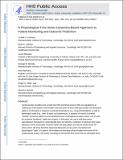A Physiological Time Series Dynamics-Based Approach toPatient Monitoring and Outcome Prediction
Author(s)
Adams, Ryan P.; Mayaud, Louis; Moody, George B.; Malhotra, Atul; Lehman, Li-Wei; Mark, Roger G; Nemati, Shamim, 1980-; ... Show more Show less
DownloadMark_A Physiological Time.pdf (587.0Kb)
OPEN_ACCESS_POLICY
Open Access Policy
Creative Commons Attribution-Noncommercial-Share Alike
Terms of use
Metadata
Show full item recordAbstract
Cardiovascular variables such as heart rate (HR) and blood pressure (BP) are regulated by an underlying control system, and therefore, the time series of these vital signs exhibit rich dynamical patterns of interaction in response to external perturbations (e.g., drug administration), as well as pathological states (e.g., onset of sepsis and hypotension). A question of interest is whether “similar” dynamical patterns can be identified across a heterogeneous patient cohort, and be used for prognosis of patients' health and progress. In this paper, we used a switching vector autoregressive framework to systematically learn and identify a collection of vital sign time series dynamics, which are possibly recurrent within the same patient and may be shared across the entire cohort. We show that these dynamical behaviors can be used to characterize the physiological “state” of a patient. We validate our technique using simulated time series of the cardiovascular system, and human recordings of HR and BP time series from an orthostatic stress study with known postural states. Using the HR and BP dynamics of an intensive care unit (ICU) cohort of over 450 patients from the MIMIC II database, we demonstrate that the discovered cardiovascular dynamics are significantly associated with hospital mortality (dynamic modes 3 and 9, p = 0.001, p = 0.006 from logistic regression after adjusting for the APACHE scores). Combining the dynamics of BP time series and SAPS-I or APACHE-III provided a more accurate assessment of patient survival/mortality in the hospital than using SAPS-I and APACHE-III alone (p = 0.005 and p = 0.045). Our results suggest that the discovered dynamics of vital sign time series may contain additional prognostic value beyond that of the baseline acuity measures, and can potentially be used as an independent predictor of outcomes in the ICU.
Date issued
2014-06Department
Massachusetts Institute of Technology. Institute for Medical Engineering & ScienceJournal
IEEE Journal of Biomedical and Health Informatics
Publisher
Institute of Electrical and Electronics Engineers (IEEE)
Citation
Lehman, Li-wei, Ryan P. Adams, Louis Mayaud, George B. Moody, Atul Malhotra, Roger G. Mark, and Shamim Nemati. "A Physiological Time Series Dynamics-Based Approach toPatient Monitoring and Outcome Prediction." IEEE Journal of Biomedical and Health Informatics 19:3 (May 2015), p. 1068-1076.
Version: Author's final manuscript
ISSN
2168-2194
2168-2208